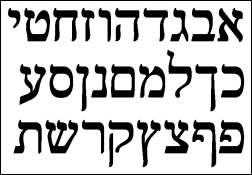Today’s date: 11th of Adar, 5772 – י״א באדר תשע״ב
שלום (Shalom)! Welcome to the new Hebrew blog hosted by Transparent Language. My name is Sean Young and I’ll be your guide.

Modern Hebrew is an important world language. It is one of the official languages of the State of Israel, and used in the Jewish communities throughout the world in worship services. It is also used by the ethnically related Samaritans. Both Modern and Classical Hebrew is used in one of the world’s major religions – Judaism – and has a long and ancient history. The Torah, and most of the rest of the Hebrew Bible, is written in Classical Hebrew (which flourished around the time of the Babylonian exile in the 6th century BCE). For this reason, Hebrew has been referred to as לשון הקודש (le-shon ha-kodesh – “The Holy Language”) since ancient times.
Modern Hebrew is written from right to left using a consonant based alphabet of 22 letters. A cursive Hebrew script is used in handwriting: the letters tend to be more circular in form when written in cursive, and sometimes look nothing like their printed equivalents. Rashi script is also a well known script that originates from Medieval times. When necessary, vowels are indicated by marks placed above or below the letters.

Rashi Hebrew Script
With this blog, I’ll be using Hebrew script along with their vowels and include their pronunciation to help you learn new vocabulary. There will be lessons for learning, things about customs and culture and the different Jewish celebrations and festivals. And if you’re hungry, I’ll include some tasty recipes.
I’ve learned Hebrew back in pre-Internet 1980 the old school way – using books and cassettes. I still have them as a matter of fact and review them whenever I feel the need to keep it up. Of course, today we have the Internet so it’s very easy to find what I need to advance my knowledge and pass it on to you.
I hope you enjoy the things you’ll be reading and learning here. And if you have any questions, comments or suggestions, feel free to post in English or Hebrew (with an English translation if possible).
טודה רבא (toda raba) – Thank you!







Comments:
Randy:
Toda raba Sean. I look forward to learning with you.
Shalom aleichem,
Randy
francisco torres mendoza:
I got a problem to use AYIN;ALEF;SAMECK and SHIN!!!!! helppppp meeeee…please
Sean Young:
Hello Francisco. I’d love to help you out. What is the problem that you’re having?
Sean Young:
תודה רנדי, וברוך הבא
Thank you Randy, and Welcome! 🙂
Sharon:
Toda Roba!!!
Thank you so much Sean for doing this! I can’t tell you how grateful I am to you for this. I’m a stay at home homeschooling mom. It is very important to me to teach my young son Hebrew (I know very very little) to impart to him our heritage as well as prepare him to make aliyah one day, or at least to serve Israel in the IDF … while on a shoestring budget.
Sean Young:
!שָׁלוֹם שָׁרוֹן (sha-lom sha-ron). I hope your son will do well in learning Hebrew. Of course, I’ll do my best to help out with this blog. If you have any questions or suggestions, please don’t hesitate to ask. I’m ready to help 🙂
!תּוֹדָה
francisco torres mendoza:
Hi sean i`m study hebrew but i got a problem i dont know when i can use it Alef and Ayin?
I hope you can help me !!!!